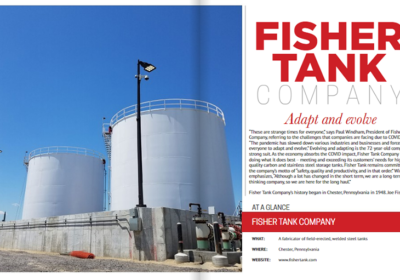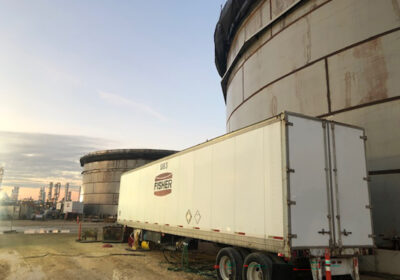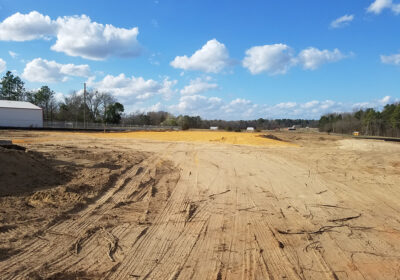OSHA’S TOP 10 APPLY TO TANK CONSTRUCTION – DO THEY APPLY TO YOU?

Fresh from Fisher Tank Company’s internal newsletter, today’s Think Tank post takes a look at the Top Ten OSHA Violations in 2014. While fewer lives were lost due to preventable workplace accidents in 2014 than in 2013, lives are STILL being lost. According to OSHA’s Top Ten Safety Violation Report, fatalities dropped from 4,628 in 2013 to 4,405 in 2014. That is the lowest number of fatalities since the census was first conducted in 1992. However, more than 4,000 people lost their lives due to preventable workplace accidents in 2014. The guy working next to you? He could have been one of those 4,405. YOU could have been one of those 4,405.
Taking a good look at this list is a powerful reminder of how important safety is every single day. Whether you’re building field erected storage tanks, like Fisher, or you’re working on a power plant, operating a terminal facility, constructing an industrial project, or performing countless other types of industrial, manufacturing or construction work, this top ten list applies to you and your fellow workers.
Check out OSHA’s Top Ten Violations in 2014 – You can bet they apply to our work as tank builders. Which violations are applicabe to your work?
#1 FALL PROTECTION
7,516 violations (1926.501)
Fall protection should be provided at elevations of four feet in general industry workplaces, five feet in shipyards, six feet in the construction industry, and eight feet in long shoring operations, and whenever working over dangerous equipment. Violations decreased by nine percent.
How do OSHA’s Fall Protection requirements affect your daily work? For tank builders, Fall Protection is huge. A field erected welded steel tank is a huge structure – and that means people have to work at heights to complete tank construction and install the tank roof and accessoires like ladders, bridges and handrails. Tank contractors work on ladders, on scaffolding, on platforms, on man lifts, etc. throughout the tank erection process.
#2 HAZARD COMMUNICATION
6,148 violations (1910.1200)
Most violations involved not having met the HazCom 2012 training deadline of Dec. 1, 2013. This included a written Hazard Communication program, established training to convert to SDS from MSDS for transporting and holding of hazardous materials. Violations decreased by 1 percent.
How does your team use HazCom 2012 documentation to protect yourselves from hazardous materials? What hazardous materials do you encounter every day, and how is your team prepared to work safely? On our jobsite, HazCom info is vital – for our own work, and in terms of the facilities where we are working – for example, if we are repairing chemical storage tanks, the MSDS info is the first step in ensuring the safety of everyone on and near the jobsite.
#3 SCAFFOLDING
4,968 violations (1926.451)
Scaffolding accidents commonly result from planks giving way, employee falls and tumbling objects. An estimated 2.3 million construction workers – 65 percent of the construction industry – work on scaffolds frequently. Violations decreased by eight percent.
Does your work involve scaffolding? For many types of construction and maintnenance projects, scaffolding is the equipment that permits workers to reach and work on parts of structures that would otherwise be inaccessible. For example, tank contractors use scaffolding when hanging steel plates and welding the fabricated plates into place to form the tank’s shell. How do you use scaffolding?
#4 RESPIRATORY PROTECTION
3,843 violations (1910.134)
An estimated 5 million workers are required to wear respirators in 1.3 million workplaces throughout the United States. Violations decreased by 1 percent.
Does your work involve dangerous fumes and particulates? Blasting steel tank interiors and exteriors and blasting steel plates requires respiratory protection, as do other tank maintenance and construction operations. Knowing the potential hazard of your work environment and employing the appropriate respiratory protection is an effective health precaution, both now and in the long term.
#5 POWERED INDUSTRIAL TRUCKS
3,147 violations (1910.178)
Forklifts, or powered industrial trucks, are efficient tools used in moving heavy loads or storing materials, but can wreak havoc. Violations decreased by six percent.
Are forklifts, man lifts, cherry pickers, cranes and other large powered industrial tools part of your jobsite(s)? In tank construction, large cranes are used to lift huge storage tank roofs into place, or to lift steel plates into postion as tanks are being built. Forklifts carry fabricated steel plate from lay down areas to tank sites for construction. If you’re working in an industrial, manufacturing or construction environment, this type of equipment is probably something you see or work around all the time. Are you aware of dangers these powered industrial vehicles can pose?
#6 LOCKOUT/TAGOUT (LO/TO)
3,117 violations (1910.147)
Most electrical accidents result from unsafe equipment, unsafe environments, or unsafe work practices. Violations decreased by four percent.
What equipment do you work with/around that requires LO/TO? Can these little red & white tags save your buddy’s life? Can they save yours? Absolutely, but only if you use them.
#7 LADDERS
2,967 violations (1926.1053)
Falls are often involved in occupational fatalities. While human error causes most ladder falls, steps can be taken to minimize injuries. Violations decreased by 11 percent.
Are ladders part of your daily work? Do you pay attention to them, or are they part of the scenery? It’s not hard to ignore ladders and ladder safety; compared to heavy equipment and power tools, ladders don’t seem all that dangerous. But complacency causes accidents, injuries and even fatalities! Ladders can’t be taken for granted on a tank construction site or in any other setting.
#8 ELECTRICAL, WIRING METHODS
2,907 violations (1910.305) Most electrical accidents will result from unsafe equipment, unsafe environments, or unsafe work practices. Violations decreased by 16 percent.
How is electricity used in your work environment? Are there power cords running everywhere? Are power connections protected? Does everyone know where emergency shut off switches are? When a tank builder is contructing a storage tank, access to power, either on site or from a generator, is necessary for the job. Safe use of electric equipment and adherence to safety standards for the use of power will protect the crew, other people on the site, and the property.
#9 MACHINE GUARDING
2,520 violations (1910.212)
Any machine part, function, or process that might cause injury must be safeguarded. Violations decreased by 9%
What types of machinery do you use in your work? How do you ensure that machine guards are in place and used properly? For welders and tank builders, their day-to-day tools are as familiar as their own hands. With that familiarity comes great skill, but it also increases the potential for danger. On any type of jobsite, even the most familiar, commonly used machinery can be dangerous. Implementing the appropriate safeguards protects everyone.
#10 ELECTRICAL, GENERAL REQUIREMENTS
2,427 violations (1910.303)
Electrical hazards are the second leading cause of deaths in the construction industry, killing an average of 143 construction workers each year. Violations decreased by 11 percent.
Like #8, Electrical, Wiring Methods, this one affects just about every type of construction and other work environment. From a welder working with a grinder inside a partially finished steel tank to an operator in a waste water treatment plant and million different jobs in between, we all work with and around power. A little bit of rainwater collected on a jobsite could have deadly implications for workers who are not watching out for electrical hazards.
DON’T CONTRIBUTE TO OSHA’S TOP TEN IN 2015!
Reviewing and evaluating OSHA’s Top Ten Violations for 2014 in terms of specific work and job sites is a great way to double check safety practices, potential pitfalls, and the roles we all play in keeping our coworkers and ourselves safe.
More info at OSHA.gov
Click here to read more of our blogs




